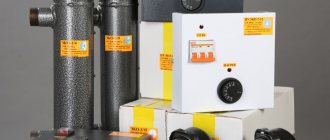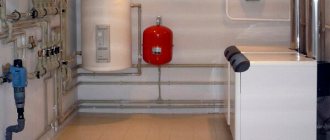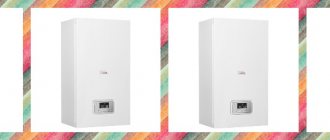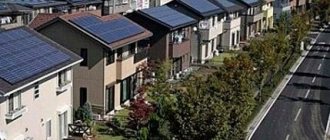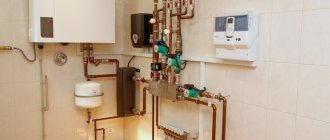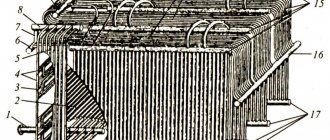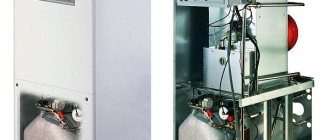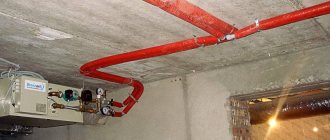Home / Electric boilers
Back
Published: March 24, 2020
Reading time: 5 min
0
1757
The ion boiler is used as a heating source in facilities where it is most efficient to use electricity.
Such devices have minimal weight and compact dimensions, making their installation simple and reliable. For installation, it is not necessary to obtain permits from regulatory authorities. In the case when it is necessary to heat a large area, not one ion boiler is installed, but several devices.
This scheme allows you not only to heat the house, but also to heat water for domestic use through an external hot water storage tank.
- 1 History of the appearance of ion boilers
- 2 Advantages and disadvantages
- 3 Design and technical characteristics
- 4 How to choose an ion boiler
- 5 Best manufacturers
- 6 Diagram of the heating system for an ion boiler 6.1 General diagram of connecting an ion boiler
- 6.2 Do such boilers need to be grounded?
The history of the appearance of ion boilers
The first ion heating boilers of the flow modification began to be installed at military facilities for heating submarines and ships of the USSR Navy. The technology was declassified in the 90s, after the collapse of the USSR.
The development of this boiler design was carried out by the Russian one. In 1994, the first serial production of GALAN ion boilers was released.
Over 20 years, the model has successfully developed, the design characteristics and materials used have changed. The creation of the Kros automation made it possible for the device to work with water of any quality, which significantly increased the scope of use of ion boilers.
“Kros” is configured during the initial start-up, and then works stably, automatically adjusting to the actual quality of the coolant, which ensures high efficiency of household heating boilers.
During operation, no manual control is required, so there are no adjustment elements on the panel, only technical condition indicators.
The boiler integrates well with external climate control units, with the ability to work in the Smart Home and DSM control systems.
Design features
The thermal fluid used is heated during the movement of multidirectionally charged ions between the electrode contacts. The design of such a heater is quite simple. It consists of: a metal rod and a hollow steel pipe.
The device is hermetically sealed on both sides. Special pipes are welded to its sides. With their help, the heater is connected to the heating system.
The phase wire is attached to the inner rod, and the neutral wire is attached to the surface of the housing. A three-phase network is used to power powerful heat generators.
Electrode (ion) type Galan boiler
Under the influence of alternating current, the ions contained in the thermal fluid constantly change the direction of their movement. Electrolysis is not carried out fully. During the heating process, there is no transfer of substance between the two electrodes.
The heating device has the following characteristic features:
- small overall size;
- simple design;
- ease of installation;
- high level of efficiency;
- long service life;
- reliability of operation - there are no contacting parts;
- low cost.
Advantages
Electrode heating boilers make it possible to regulate the indoor microclimate and save electrical energy. If we compare their efficiency with the efficiency of induction devices and heaters, which include heating elements, we should note the advantages of the electrode design:
- the water entering the boiler is heated very quickly;
- efficiency level approaches 100%;
- long service life. The design features of the device cause rapidly changing polarity. Ions constantly change the direction of their movement. Therefore, despite the presence of constant contact of the surface of the electrodes with the liquid, scale does not form on them;
- the electric electrode boiler has small dimensions;
- it is easy to install in any room;
- there is automatic control of the operation of the heating device;
- The heater has a high level of fire safety. If the system depressurizes, the risk of electric shock is eliminated. The device will simply stop working;
- there are no extraneous noises during operation of the heating system;
- electrode electric boilers for heating a private home do not have a harmful effect on the environment;
- chimneys are not used during their operation;
- devices are not afraid of voltage surges
Flaws
Despite the high quality performance of electrode heating systems, certain disadvantages should be taken into account:
- for high-quality functioning of the heater, pre-prepared water is required, which has a given resistivity;
- Distilled water, antifreeze or oil cannot be used as a heat carrier;
- An electrode electric boiler for heating can operate effectively only with continuous circulation of liquid. If the movement speed decreases, the likelihood of the system boiling increases. If it increases, difficulties may arise with starting the heating unit;
- Over time, the substance that makes up the electrodes dissolves in water. They have to be replaced periodically;
- the heating system must have a grounding circuit;
- when the temperature of the coolant increases above 75 degrees, the consumption of electrical energy increases sharply;
- in single-circuit devices, the liquid cannot be used for domestic needs.
Advantages and disadvantages
There is a lot of conflicting information in the technical literature about the operation of ion boilers. However, the achieved technological parameters of the operation of such a heating system indicate its significant advantages compared to similar heating devices operating on electricity:
- The highest efficiency level is 90-98%, higher than that of conventional heating elements structures.
- High speed of ion heating boilers reaching operating power.
- Small dimensions and weight, which simplifies the piping of the ion boiler.
- There is no need to install a smoke ventilation system. heated room.
- There is no overheating or coolant leakage.
- Voltage drops in the network slightly reduce the power of ion heating boilers, but do not stop the process of heating the coolant.
- Can be placed in a heating circuit with a traditional boiler running on any fuel as an additional source of heating at night or during peak load hours.
- Cascade installation of several ion units with stepwise adjustment of heating power is allowed.
- With proper disposal of waste coolant, ion boilers absolutely do not pose a threat to the environment.
- They have a low cost compared to traditional units.
Disadvantages of ion boilers:
- Specific parameters for the quality of the heating medium.
- Not all heating devices can work in tandem with ion electrode boilers. Experts recommend using bimetallic or aluminum batteries. Moreover, the latter should not contain oxides, which can change the chemical composition of the electrolyte and imbalance the operation of the entire system.
- High requirements for electrical grounding.
- The maximum temperature limit is up to 70 C.
- The electrodes quickly become covered with scale and require periodic replacement.
- It is unacceptable to work in the DHW heating circuit.
Principle of operation
In heating equipment powered by electricity, heat is generated by heating a conductor through which a large electrical current flows. Exceptions include heat pumps and air conditioners, however, the working fluid in them is not electricity as such.
If in heating element or induction boilers the conductor and heater is a refractory metal wire or the body of the device, then in electrode boilers the current is passed directly through the coolant.
Water containing salts and other impurities is a good conductor, and when current is passed through it, as is the case with any conducting medium, heat is released in proportion to the strength of the current.
An electrode boiler is always a flow-type design. The electrodes are fixed inside the boiler in such a way that there is a small gap between them. Electric current passes only if the space is filled with a conductive liquid.
When the power is turned on, a potential difference occurs between the electrodes. Negative and positive salt ions present in the coolant rush to the correspondingly charged electrodes. Collisions of molecules during movement are accompanied by the release of heat, which heats up the solution.
The electrode boiler is powered by alternating voltage. The sign of the charge on the electrodes changes with a frequency similar to that of the supply line - 50 Hz. Changing the polarity protects the system from the formation of electrolysis gases, the stable splitting of water into hydrogen and oxygen, and the deposition of salt components on all conductive surfaces.
Boiler operation diagram
The bottom line is:
Heating the coolant without the use of intermediaries.
The correct choice of coolant with a conductivity of at least 1 kOhm/cm is important.
The boiler and heating require thorough grounding, otherwise users may be electrocuted when in contact with metal elements of the system and static discharge in the case of polymer surfaces.
Among the features of electrode boilers, it should be noted:
- The electrode deteriorates over time and requires regular replacement; if this is not done, the efficiency of the boiler decreases and the risk of arc breakdown increases. Which is dangerous for the entire electrical system of the house.
- Requires a powerful electrical input into the house, a separate power supply branch and always before the RCD (Residual Current Device).
The boiler manufacturer regulates the maximum permissible volume of coolant in the system. The approximate ratio is 10 liters for each kW of power. This is easy to achieve if the heating is designed from scratch. However, the inclusion of a boiler in an existing design, for example, with cast iron radiators with large sections, will lead to a significant decrease in the efficiency of the boiler or its incorrect operation.
The conductivity of the solution increases with its temperature, therefore the indicated rated power is only achieved at 70°C or 90°C.
Device and technical characteristics
This method of instantly heating the coolant is not some kind of modern development; it has existed for several decades, so today models are produced by several companies. The designs are basically similar and differ only in minor details.
This is usually a vertically mounted cylinder, with a wide lower part where the electrical switching unit is located. The design contains two pipes for supply and return coolant.
Electrodes are installed inside the device. When working in a 220 V line, there is one electrode in the center, and in a 360 V line, there are three insulated electrodes made of specialized alloys, secured with protected polyamide nuts.
In addition, the design contains:
- control unit;
- control unit controller;
- low quality voltage protection;
- power and ground terminals;
- rubber gaskets for insulation
- insulating.
Average characteristics of a domestic ion boiler:
- diameter of the electrode boiler – up to 300-350 mm;
- length – approximately 600 mm;
- weight of one installation is from 10 to 12 kg;
- thermal power from 2.0 to 55.0 kW.
An indispensable component of an ion boiler unit is a special coolant, which must necessarily meet the conditions specified in the technical instructions of the manufacturer.
Design Features
An electric boiler is a device consisting of several basic elements:
- a tank with water that enters and leaves after reaching a certain temperature;
- heating element (there are different types);
- thermostat (temperature sensor and adjustment device);
- a circulation pump that ensures stable movement of fluid in the system.
There are simpler models, consisting of a regular tank, two pipes for connecting the forward and return heating lines and a pipe for make-up (connection to the water supply).
There are more complex devices capable of executing programs and changing the operating mode in accordance with them.
The most common are boilers that use heating elements. As a rule, several pieces are installed so that the heating mode can be adjusted, turning on one or more heaters in turn.
These units are considered the most inefficient, since their energy consumption is high and their durability is relatively short.
Another type of heating elements are electrodes. Metal rods are simply lowered into the water, to which phase and zero are supplied. Most often, zero is supplied to the metal body, and the phase is supplied to a rod immersed in water inside the container.
Water conducts electricity, creating a potential difference. The water is heated naturally and leaves the tank. Such boilers are very reliable and durable, but their electrodes gradually dissolve and require replacement.
The newest type is the induction heater. It consists of a coil with a massive dielectric core that heats up when the coil is connected to a power source. This design has high efficiency and is the most durable device of all currently existing varieties.
When choosing one or another unit, it is necessary to take into account its operating mode and load level. If it is large, models with heating elements will not be suitable. The best option would be an induction boiler, but it is quite expensive.
It is possible to make a homemade induction heater that works no worse than a factory one and does not require too much assembly costs.
How to choose an ion boiler
The required power unit is selected from the condition that 1 kW of thermal power is sufficient to heat an area of 10 m2. You need to add approximately another 20% to the calculation to take into account the heat losses of the object.
In addition, before choosing, you need to clarify what function it will perform in the heat supply scheme, as the main source of heat or auxiliary to maintain the temperature at night or during periods of extremely low outside temperatures.
It will also be necessary to take into account the electrical load mode of 220V or 380V, and the possibility of an intra-house electrical network carrying the load through such a boiler. To select a specific model, you will need to take into account the heating scheme, so if the house has a “warm floor” system, the boiler power is selected 30% more.
Economical electric boiler for heating: myth or reality
Some manufacturers repeat like a mantra what kind of energy-saving electric heating boilers they make. The benefits are simply colossal; it comes to the point that the efficiency of the units reaches as much as 400%. It’s incredible, you might think, it would be a shame not to take advantage of such a benefit.
What is the deception? Everything is quite simple, there are laws of physics, which, although many scientists are trying to challenge, are still to no avail. One of the laws is the law of conservation of energy. It is better to call it the principle of conservation of energy, according to which energy passes from one state to another with complete preservation of its value.
Based on this, we can conclude that even a supposedly energy-saving electric heating boiler will give out exactly as much energy as it consumes, no more, no less. In addition, when product data sheets say that the efficiency of the unit is 98% or 95%, this is all sheer nonsense. The efficiency of any heater is exactly 100%. We talked about the operating principle of electric boilers last time.
It turns out that a priori there cannot be any economical electric boilers for heating. The only difference may be the method of converting electrical energy into thermal energy and the speed of this process. A list of questions to ask when you are offered to buy the most economical electric heating boiler:
- whether errors were found in the law of conservation of energy;
- whether Noether's theorem has been refuted;
- has the mystery of Nikola Tesla been solved?
- whether the developer received the Nobel Prize.
How does everything work in practice? All electric heating boilers have exactly the same energy consumption. To heat a liter of coolant by one degree, the boiler spends 0.001 kW of energy. The device works as an intermediary. It takes energy from the network and converts it into heat, heating the water. How he does it doesn't matter. All the same, he will give back exactly as much as he took, leaving nothing for himself. Even that small part that heats not the coolant, but the body, is still ultimately transferred to the air. Why then did they come up with the term economical electric boiler for heating a private home?
Marketing and more marketing. If you have a choice between a simple unit and an economical electric heating boiler, which one will you choose? Of course, the second one. Considering the fact that this is a special device, it is natural that the latest highly complex technologies were allegedly used for its production. They are very expensive and require a lot of labor. It’s no wonder that an economical electric boiler for heating a house will cost more, but then what benefits does its owner promise. All this in order to increase sales. Oh, this wild capitalism that came to us from the West.
Superimposed on this is general illiteracy and unwillingness to understand the essence of the matter. On the contrary, it is said that this is an economical electric boiler for heating a house, which means that it is so, because no one wants to admit even to himself that he was simply cheated. People buy them, and then intensively look for benefits during operation and find them. It is only interesting what their conclusions are based on, if, most likely, the boiler purchased by the economical is the first in their practice and there is nothing to compare it with.
Therefore, do not believe advertising, be skeptical and check everything down to the smallest detail. If manufacturers really made such a breakthrough, then why are they silent about it? Let them announce their discovery to the whole world. For this they are promised not only the recognition of their colleagues, but also a significant monetary reward in the form of the Nobel Prize.
The best manufacturers
Due to their advantages, ion boilers remain very popular sources of heat supply on the Russian market.
They are produced by a number of domestic factories, and there are also models from Western manufacturers.
General overview of the most popular brands:
- "Galan", a boiler unit from a Moscow company. The company produces several basic models on a 220 V network: "Ochag", "Turbo" and "Geyser", and on a 380 V network - "Vulcan". For the devices you will need to buy a main control unit "Navigator", a circuit breaker "ABB", a thermostat "BeeRT", which controls the performance of the circulation electric pump.
- Electrode ion boilers Beryl, a Russian manufacturer, are available in 2 standard sizes for a 220/380 V network and, accordingly, with a power of 9/33 kW. It has a top-mounted power supply unit, which simplifies installation and maintenance. It is necessary to additionally purchase a “Euro” CSU unit, which allows for stepwise control of the coolant heating power every 200 W.
- Electrode boilers of the EOU brand of a domestic manufacturer, with a power range from 2 to 120 kW, in a 220/380 V network.
- "Forsazh" of the Ukrainian manufacturer are equipped with a special protective casing that increases safe operation and has a designer appearance. It is presented in 5 modifications for a 220 V network, with a power from 3.0 to 20 kW, which are equipped with an ECRT control unit.
- STAFOR, a Latvian manufacturer, complies with EU requirements. The design has a number of innovative solutions, including the use of a “Faraday cage” with distribution of safety and working zero. Together with it, it is possible to buy a branded coolant and a specialized additive STATERM POWER, which allows timely adjustments to the chemical composition of the electrolyte to regulate the efficiency of the boiler.
basic information
Due to the constant rise in energy prices, property owners are increasingly thinking about switching to alternative heating sources. If previously many people did not even think about connecting an electric boiler due to the price of this resource, today more and more people are choosing just such equipment.
In addition, the design and ease of operation are considered interesting. The units can fit into any interior, be it an apartment, a country cottage or a country house.
Don't forget about the ease of installation. After all, in fact, all you need is a connection to the electrical network. Moreover, when compared with models that use heating elements, savings reach 30%.
Energy-saving electric boilers are also called electrode or ion boilers. Some divide them into types, but this makes no sense, since they have the same operating principle.
You need to know that high energy saving rates can be achieved not only because of the equipment itself, but also due to many other factors:
- Reduced heating inertia.
- Smooth start.
- Automatic control of air and coolant temperature conditions.
- A simple design, created using only modern materials.
- Reliability.
Diagram of a heating system for an ion boiler
The ion heating element must be turned on by special installation electrical personnel with a clearance group, since this is due to the electrical safety requirements of the equipment.
To carry out commissioning work, you can use the diagram provided by the manufacturer.
General connection diagram for an ion boiler
For installation you will need:
- Ion boiler.
- Ball shut-off valve for the possibility of closing the coolant in an emergency or changing the heating medium in the system.
- Centrifugal electric pump for circulating coolant in the heating network.
- Filter for cleaning the coolant from suspended substances.
- A drain valve for draining water from the system is installed at the lowest point of the return pipeline.
- Expansion tank to protect against network breaks due to thermal expansion of the coolant.
- Control and protection unit.
- Air intake.
For the normal functioning of an ion heating boiler, water of a strictly defined composition is required. If the boiler will be installed in an existing heating network, before the first start-up it will be necessary to replace the coolant and add a special inhibitor. The water itself must be distilled.
Do such boilers need to be grounded?
Production standards for the operation of an ion boiler unit require the mandatory installation of a grounding system that complies with the PUE, for the reason that in the event of a current leakage, this system cannot be protected using an RCD.
The grounding copper conductor must have a diameter of 4.0 to 6.0 mm, and the system resistance cannot exceed 4 ohms. The electrical wiring is connected to the “0” terminal located in the lower part of the boiler structure.
All accessible electrically conductive parts of the boiler unit and heating network are grounded, this can extend the service life of the heating source. Corrosive wear of the grounding system cannot exceed 50%.
The structure of the grounding system must not be painted or covered with dielectric coatings. A heating system equipped in accordance with the requirements of the PUE is a reliable and efficient source of thermal energy.
Coolant
Electrode boilers are sensitive to the composition of the coolant.
In accordance with the requirements of the manufacturers, only distilled water should be used, to which table salt is added, approximately 80-100 grams for every 100 liters. The difficulty lies in the fact that the final density and conductivity of the solution must be in strict accordance with the manufacturer's requirements. It is impossible to determine the exact amount of salt, and it can give different results depending on its composition. The final preparation of the solution is carried out locally, based on the actual current values in the electronic boiler. The instructions for the device provide a table of the required values depending on the boiler power, coolant volume, etc. By adding distilled water or salt, the coolant resistance is brought to ideal.
Only compounds provided by the boiler manufacturer are used as antifreeze. When they are used, the proportion of salt in the solution also changes.
There is a mandatory requirement before using an electronic boiler in an existing heating system in parallel with another boiler. The entire system is washed, cleaned of scale and salt deposits, which can subsequently change the conductivity of the coolant.
